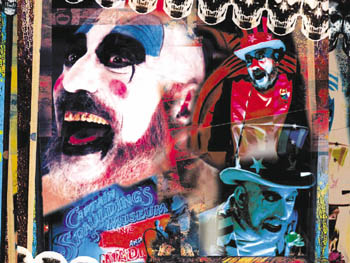![[Metroactive Movies]](http://metroactive.com/movies/gifs/movies468.gif)
[ Movies Index | Show Times | Santa Cruz | Metroactive Home | Archives ]
Grindhouse Party
Rob Zombie's 'House of 1000 Corpses' takes horror back to a bygone era of exploitation
By Steve Palopoli
Rob Zombie promised fans several years ago that his directorial debut was going to set the horror film back at least 20 years. It sounds like a threat, and only if you're a hardcore fan of the genre would you know that it's actually a good thing, a coded promise to get back to the grungy exploitation days before the era of slick, tongue-in-cheek and--most offensive of all--"respectable" Hollywood horror films.
Of course, only if you're a hardcore fan would you even care, and that's why it's important to say up front that Zombie's House of 1000 Corpses is not for everyone. Matter of fact, it's for hardly anyone. This is a movie so twisted and gruesome that it was dropped by two studios, Universal and MGM, before finally being picked up by everybody's favorite daring little independent, Lions Gate. It's only seeing release in theaters now, though it was finished nearly three years ago.
I've gotta say I love to see a movie rankle the industry's feathers like this, and not in that overblown Natural Born Killers way, but in the grimy, low-budget way that seems far more authentic. If you're not a fan, it's fair to ask why anyone would want to see a movie like this, but the answer is simple: besides the visceral thrill of a horror movie that truly gets under your skin, the low-budget shockers that followed in the wake of '60s films like Blood Feast and Night of the Living Dead were some of the most subversive movies in history, combining a carny promise of taboo gore and grue with a pitch-black vision of American Gothic. The '70s was a particularly heady time for horror, with a slew of Watergate-era counterculture kids taking up moviemaking and infusing anti-authoritarianism, class consciousness and technophobia into the only kind of film most of them could afford to make: grindhouse shockers.
About the biggest criticism that a fan of these films could level at Zombie's loving tribute is that it's for the most part simply a recycling of their style and substance, though it's pretty stunning to see either resurrected in this day and age. Particularly well-harvested is Tobe Hooper's 1974 cult classic The Texas Chainsaw Massacre, a movie that nearly three decades later remains unpalatable to mainstream culture, mostly because of its outlandish title. Though Chainsaw is incredibly intense and possibly the most truly nightmarelike film ever released, it actually contains very little gore (the story goes that Hooper originally wanted to put it out with a PG rating under the title Head Cheese). To Zombie's credit, he hasn't drenched his film in buckets of blood, either, trying instead to hit a raw nerve by flashing quickly on lurid images, creating an atmosphere of menace and hinting at off-the-scale taboos like incest, cannibalism and necrophilia.
Hooper's original film was loosely based on the exploits of serial killer Ed Gein, and Gein shows up in House of 1000 Corpses, too, as part of a "murder ride" staged by some hick types for the benefit of condescending tourists. The theme of lower-class (usually backwoods country) folk vs. middle-to-upper-class city folk runs like some kind of baseline grid through '70s horror (Deliverance is probably the most mainstream example), and Zombie does a great job of reviving the theme in a clever and very-in-your-face way. We see it most visibly early on, when the operator of the carnival, Captain Spaulding (Sid Haig), alternately berates and sucks up to a group of city kids--he both knows and resents that his livelihood depends on their dollars, and he is in a sense "feeding" off them the same way they are "feeding" off him to bring some cheap thrills into their modern lives, the same way the audience is "feeding" off the film itself. You can see why cannibalism was a popular horror metaphor in the '70s.
From there, the film roughly follows the plot of Chainsaw, with the kids driving out into the boondocks to check out the legend of "Dr. Satan." They break down near a house owned by a crazy family with names like Otis, Baby and Mother Firefly. Now, these tourists wouldn't be horror movie kids if they didn't take way too long to figure out they're in deep shit, and indeed they do. As the family closes the net, all that's really left is to figure out, as the tagline for the original Chainsaw put it, "Who will survive--and what will be left of them?"
Along the way, Zombie draws from an array of other films from that decade, including another Hooper film, The Funhouse; two early Wes Craven nasties, Last House on the Left and The Hills Have Eyes; and even lesser-known horror oddities like Don't Look in the Basement. The climax of the film is a revisiting of Dario Argento's 1977 classic Suspiria, and as the tone and look of the film suddenly changes to mimic Argento's art-horror style, you have to admire the sheer glee Zombie gets from unabashedly aping his heroes, and the entertaining roller-coaster ride of throwback horror he's crafted in which to do it.
[ Santa Cruz | Metroactive Central | Archives ]
Copyright © Metro Publishing Inc. Maintained by Boulevards New Media.
![]()

Insane Clown Posse: And, best of all, he's available for parties!
House of 1000 Corpses (R; 105 min.), directed and written by Rob Zombie and starring Karen Black, Sid Haig and Bill Moseley, plays at the Santa Cruz Cinema 9.
From the April 23-30, 2003 issue of Metro Santa Cruz.